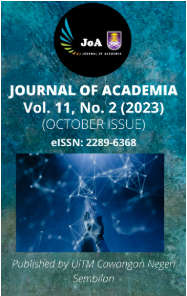UNCERTAINTY AND MALAYSIAN FINANCIAL MARKETS
Keywords:
Uncertainty, Stock, Commodity, ARDL, MalaysiaAbstract
This study examines the long run cointegration relationship of two uncertainty indices namely the Global Economic Policy Uncertainty (GEPU) and Geopolitical Risk (GPR) on the returns of Malaysian stock and commodity market for the period from January 2000 to December 2022. The Malaysian stock market is represented by the Bursa Malaysia Kuala Lumpur Composite Index (KLCI) whilst the Malaysian commodity market is represented by the Bursa Malaysia Crude Palm Oil Futures (FCPO). The Autoregressive Distributed Lag (ARDL) approach is used to analyze the possible long-run cointegration between the uncertainty indices and the stock and commodity market’s return. Our findings show that GEPU has a significant impact on the stock market and commodity market returns. We discover that GEPU has a significantly negative impact on the returns of the stock and commodity market over the long run. GPR, on the other hand, positively affects the return of stock market and negatively affects the return of commodity market in the long run. According to the findings, it is strongly advised that investment managers and investors in the Malaysian stock and commodity markets pay greater attention to the volatility of GEPU and GPR both in the short run and in the long run in order to control the risk of return in the stock and commodity market. In addition, policymakers should be strongly encouraged to keep a careful eye on the movement of the GEPU and GPR index, since this indicator is a significant factor in determining the returns of the Malaysian financial markets.
References
Abid, I., Dhaoui, A., Kaabia, O., & Tarchella, S. (2023). Geopolitical risk on energy, agriculture, livestock, precious and industrial metals: New insights from a Markov Switching model. Resources Policy, 85, 103925.
Baker , S. R., Bloom, N., & Davis , S. J. (2016). Measuring Economic Policy Uncertainty. The Quarterly Journal of Economics, 131(4), 1593-1636.
Balcilar , M., Gupta , R., Kim, W. J., & Kyei, C. (2019). The role of economic policy uncertainty in predicting stock returns and their volatility for Hong Kong, Malaysia, and South Korea. International Review of Economics and Finance, 59, 150-163.
Caldara, D., & Iacoviello, M. (2018). Measuring Geopolitical Risk. International Finance Discussion Paper, 2018(1222), 1-66.
Chen, J., Jiang, F., & Tong, G. (2017). Economic policy uncertainty in China and stock market expected returns. Accounting and Finance, 57(5), 1265-1286
Cunado, J., Gupta, R., Lau, C. M., & Sheng, X. (2019). Time-varying impact of geopolitical risk on oil prices. Defence and Peace Economics, 31(6), 692-706.
Davis, S. J. (2016). Index of Global Economic Policy Uncertainty . National Bureau of Economic Research, w22740.
Dutta, A., Bouri, E., & Saeed, T. (2021). News-based equity market uncertainty and crude oil volatility. Energy, 222, 119930.
Gursoy, S. (2021). The Effects of Monetary Policy Uncertainty of US and Japan on Bitcoin Price. Yalova Sosyal Bilimler Dergisi, 11(1), 7-16.
Irani, F., Athari, S. A., & Hadood, A. A. (2021). The Impacts of Country Risk, Global Economic Policy Uncertainty, and Macroeconomic Factors on the Turkish Tourism Industry. International Journal of Hospitality & Tourism Administration, 23(6), 1242-1265.
Kyriazis , N. A. (2021). The effects of geopolitical uncertainty on cryptocurrencies and other financial assets. SN Business & Economics, 1(1), 5.
Ma, F., Lu, X., Wang, L., & Chevallier, J. (2021). Global economic policy uncertainty and gold futures market volatility: Evidence from Markov regime-switching GARCH-MIDAS models. Journal of Forecasting, 40(6), 1070-1085.
Micallef, J., Grima, S., Spiteri, J., & Apoga, R. R. (2023). Assessing the Causality Relationship between the Geopolitical Risk Index and the Agricultural Commodity Markets. Risks, 11(5), 84.
Mo, B., Mu, J., & Zhang, B. (2019). The relationship between news-based implied volatility and volatility of US stock market: What can we learn from multiscale perspective. Physcia A: Statistical Mechanics and its Applications, 526, 121003.
Pesaran, M. H., & Shin, Y. (1995). An autoregressive distributed lag modelling approach to cointegration analysis (Vol. 9514). Cambridge, UK: Department of Applied Economics, University of Cambridge.
Raza, S. A., Masood, A., Benkraiem, R., & Urom, C. (2023). Forecasting the volatility of precious metals prices with global economic policy uncertainty in pre and during the Covid-19 period: Novel evidence from the GARCH-MIDAS approach. Energy Economics, 120, 106591.
Sahin, E. E., & Arslan , H. (2021). An Analysis of the Effects of Geopolitical Risks on Stock Returns and Exchange Rates Using a Nonparametric Method. The Journal of Accounting and Finance, 89, 237-250.
Salisu, A. A., Ogbonna, A. E., Lasisi, L., & Olaniran, A. (2022). Geopolitical risk and stock market volatility in emerging markets: A GARCH – MIDAS approach. The North American Journal of Economics and Finance, 62, 101755.
Yu, H., Fang, L., & Sun, W. (2018). Forecasting performance of global economic policy uncertainty for volatility of Chinese stock market. Physica A: Statistical Mechanics and Its Applications, 505, 931-940.
Zhang, Y., He, J., He, M., & Li, S. (2023). Geopolitical risk and stock market volatility: A global perspective. Finance Research Letters, 53, 103620.
Downloads
Published
Issue
Section
License
Copyright (c) 2023 Journal of Academia

This work is licensed under a Creative Commons Attribution-NonCommercial-NoDerivatives 4.0 International License.












